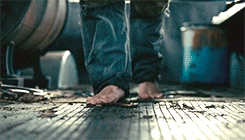Some spectacular imagery: scenes from Life of Pi (2012) the “animal story”, Pi Patel’s version, and his so-convincing depiction of the truth.
https://ginamoran.wordpress.com/wp-admin/post.php?post=62&action=edit&message=1
How do we know what is real? Is there anything we can know for sure?
Life of Pi (2012) Does the theory of simplicity (Chater et. al, 2003) cut it for you?
“Pluralitas non est ponenda sine neccesitate” or “plurality should not be posited without necessity.” The words of the medieval English philosopher and Franciscan monk William of Ockham (ca. 1285-1349)
Humans for much of history have been seeking and exploring the possibilities within the philosophical question, “is there anything we can know for sure?” We tend to be inconclusive, we disagree, and for good reason because how can we as fundamentally subjective human beings really know anything for sure? The relativity of truth is what fuels differing opinions about the success, and can result in a resonating response to this film. Our love for exploring possibilities within its mode presents us philosophical questions as an audience helps us to really think about how the original author and directors of the film choose to present us with and make us think about the plural stories and the truth behind them. So enhancing are the visual aesthetics that normalised constructions of reality can be thrown out the door and we can actually struggle at determining which story might be true.
The true one that lies somewhere within this film forces consumers and viewers to make up their own minds of which must be the true story that occurred. They aren’t hand fed a storyline to believe, in fact they are challenged to see truth in both and have to decide without aid of clues in the film. For some of us, the simplest explanation, the “human story”, we don’t want to believe, and struggle down a journey of acceptance that theories of simplicity can not always be the right answer, or truth.
William of Ockham declared that “plurality should not be posited without necessity”, and the originator of this story, the author of the book, Yann Martel asserted in his novel that “to choose doubt as a philosophy of life is akin to choosing immobility as a means of transportation.” Existentialism forces us to explore possibilities, and maybe even believe in more than one at different points. Life of Pi, which envelopes its audience with visual wonders and spiritual questions (Higgins, 2013) explores oppositional stories, the simplest one as likely not true, in my own opinion. However this claim could be disputed and sometimes I want to believe the simplest one as truth taking to heart the philosophy of Occam’s Razor. But could this be the justified, true belief? Or is one being conned, by an imaginative boy and his fantasies? This is a necessary dilemma to investigate: am I unable of opening up my mind to the other perspective?
For those who can not bring themselves to question, and theologically reflect on which story to believe in as Kendrick (2012) refers to as the ‘animal story’ as the first account and the ‘human story’ as the second account as what really happened he also highlights that Pi successfully helps skeptics overcome one of the largest hurdles to faith – believing in the unbelievable.Of course, it is completely fictional in construction, and unfortunately with knowledge of that makes the wonder of the film is somewhat diminished, but the production skills allow oneself to forget for a time that this could even be a possibility. It comes down to preferences, and which story you will prefer to take as the true story: the animal story or the human story. Each to his own must subjectively determine which is true to them and some viewers can’t handle not being told what to believe. The inconclusiveness of the relativity of truth accurately explores this philosophical conundrum as we have over our human history.
We learn this is a time he claims he would always remember that was filled with wonder urging us to consider it as possible, as true. The other must be the real account as by construction it is simpler albeit Freudian in construction as Pi Patel couldn’t cope with the “human story”, and two Ministry of Transport officials assist him to confront his “made up story”. This film makes us choose our own preference and unfortunately that is all we can really use to interpret this film and this existentialist’s conundrum that lies within it, if we care to indulge ourselves in thinking about truth and reality and furthermore, what we believe.
References
Lee, A. (Netter, G., Womark, D.). (2012). Life of Pi. United States: Rhythm & Hues and Fox 2000 Pictures.
Higgins, G. (2013, Top 10 of 2012. Sojourners Magazine, 42, 41-41. Retrieved 19/04/2012 from http://search.proquest.com/docview/1327099844?accountid=13380
Alasuutari, Pertti (2004) Social Theory and Human Reality. SAGE Publications Ltd.: London
Kendrick, B. (2012) ‘Life of Pi Ending Explained’ accessed 19/04/2012 on http://screenrant.com/life-of-pi-movie-ending-spoilers/2/Summa Totius Logicae, i. 12, cited in: Paul Newall (2005) “Ockham’s Razor” at www.galilean-library.org
Chater, N. & Vitányi, P. (2003). Simplicity: a unifying principle in cognitive science?. Trends in cognitive sciences, 7 (1), 19-22.









